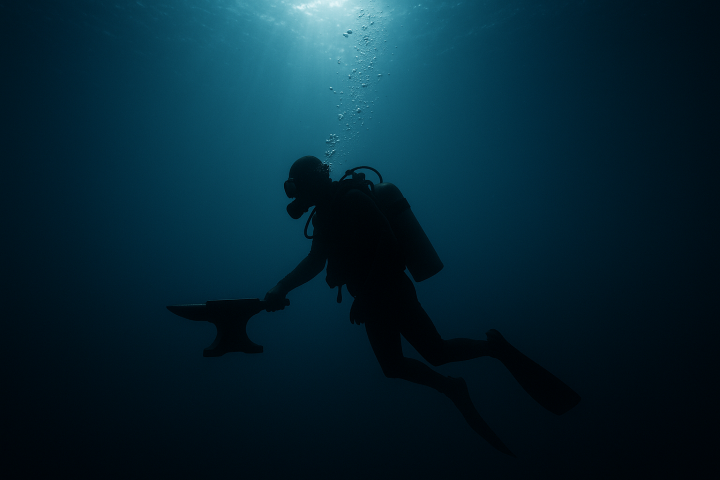The Right dive suit for Tropical Waters: Why You Should Consider Buying a Second Dive Suit
- The Introvert Traveler
- Jul 31
- 4 min read

If you’ve already read my posts about diving in tropical destinations like the Red Sea, Raja Ampat, or Cozumel, you’ll know I have a soft spot for warm waters, perfect visibility, and the thrill of drift diving. I’ve also covered in detail the topic of proper weighting, explaining how crucial it is to find the right balance between buoyancy, comfort, and safety.
However, there’s a related aspect I haven’t yet addressed, and it deserves attention: the choice of dive suit in relation to the weight required, especially when planning dives in warm waters — such as those found in some of the world’s most renowned diving spots like Indonesia, the Maldives, or again, the Red Sea. In these settings, water temperatures often hover around 30°C (86°F), and, in the absence of a thermocline, they typically remain consistent throughout the dive at any depth allowed in recreational scuba. Under these conditions, the classic “all-purpose” 5mm wetsuit might not be the most suitable choice.
Instead, a 3mm full wetsuit — or for some divers, even a shorty — may be the optimal solution. Here’s why owning two wetsuits is not a consumerist whim, but a practical choice for serious divers.
Why a 3mm dive suit Can Make a Difference
A 3mm wetsuit is often seen as the “smart middle ground” between thermal protection and buoyancy. Unlike 5mm or 7mm wetsuits, which provide substantial positive buoyancy and therefore require additional weights to compensate, the 3mm suit is thinner, more neutral, and typically requires significantly less lead to achieve a proper trim.
Less neoprene = less buoyancy = less weight.
It’s a simple equation, but one with game-changing implications once you experience the benefits of diving with the lightest possible weighting.
The Benefits of Reduced Weighting
Less physical strain: Every extra kilo of lead is a kilo you have to carry — in and out of the water. Reducing your weight load means less fatigue during transport, donning, and doffing. Even on a liveaboard, where you’re supported at every stage by attentive staff, you’ll appreciate the difference when stepping from the boat to the dinghy in rough seas — or when climbing the ladder after a long dive, or worse, when you're on your fourth dive of the day. And let’s not even mention shore dives on rocky beaches.
Better trim control: Less weight = more precise movement, especially when swimming horizontally or holding a constant depth for underwater photography.
Air consumption savings: A stable, well-balanced trim means less effort to maintain position, which translates into lower breathing rates and longer, more relaxed dives.
Improved safety: With less ballast to manage, it’s easier to deal with emergencies, both at the surface and during ascent. The risk of uncontrolled ascents due to mismanaged buoyancy is greatly reduced.
Lower environmental impact: Heavy divers tend to “bounce” off the seabed or knock into corals. A lighter trim leads to a more respectful approach to marine ecosystems.
As a bonus, a 3mm suit also takes up less space in your luggage, dries faster (wet wetsuits = heavier luggage), and is easier to put on and take off — a major plus on liveaboards, where gearing up four times a day makes the 5mm the only real annoyance of an otherwise perfect diving trip.
The Shorty Temptation: Lightweight, but with Caveats
Some divers — often more experienced or simply inclined toward minimalism — choose to dive in a 3mm shorty, leaving arms and legs exposed. The appeal is clear:
Maximum freedom of movement
Speed and ease when gearing up
Ultra-light packing for travel
Minimal buoyancy = minimal weights
But there are serious downsides to consider:
Limited thermal protection, especially on multiple dives, windy surface intervals, or long dives.
Increased exposure to stings, scrapes, and irritants (hydroids, fireworms, coral contact, oxidized ladders, etc.).
Progressive cooling can occur even in warm water (>28°C) if multiple dives are done per day.
In my opinion, a shorty is only advisable under very favorable conditions: single dives, calm seas, and genuinely warm water. For everything else, a full-length 3mm suit is a better choice. If you tend to get cold easily, you can even wear a rash guard underneath to improve thermal protection without adding bulk (but only if you're really cold-sensitive).
A Matter of Diving Philosophy
In the end, diving is an exercise in lightness and control. The diver who can do more with less — less lead, less neoprene, less effort — is also the one who can better focus on the environment, observe, photograph, and explore with grace and awareness.
Choosing the right wetsuit — and with it, the right weight system — is not just a technical matter, but a way of defining how you move and exist underwater. So, if you’re planning dives in warm or temperate destinations, think carefully: it might be time to add a reliable 3mm wetsuit to your gear closet.
Owning two wetsuits may seem unnecessary or even indulgent, but once you’ve experienced the ease of donning a 3mm suit in tropical waters — and the improved trim that comes with it — you’ll never look at your 5mm the same way again. The 5mm will remain a necessary evil for colder environments, but warm-water diving calls for a different configuration. One that’s lighter, simpler, and ultimately — more enjoyable.




Comments